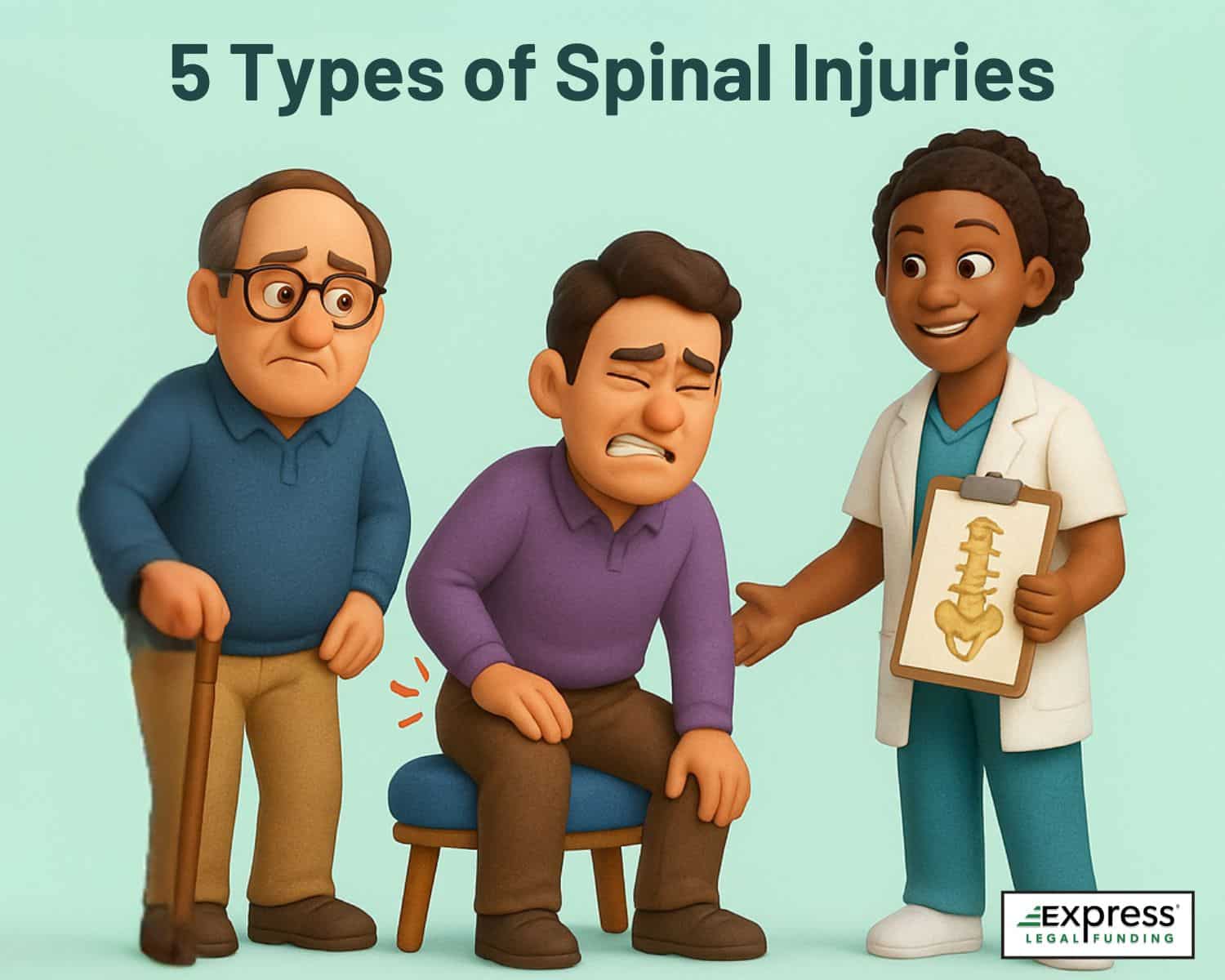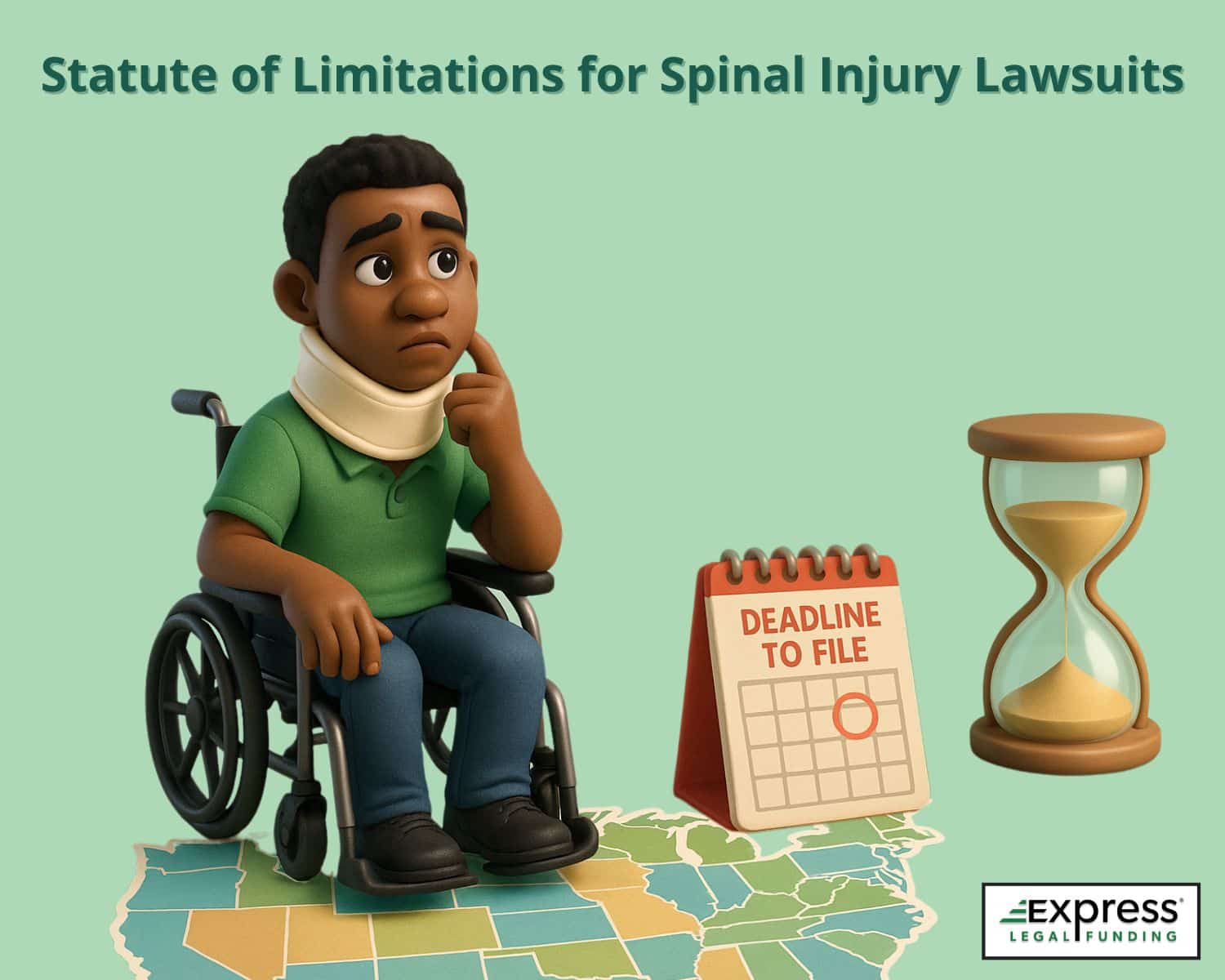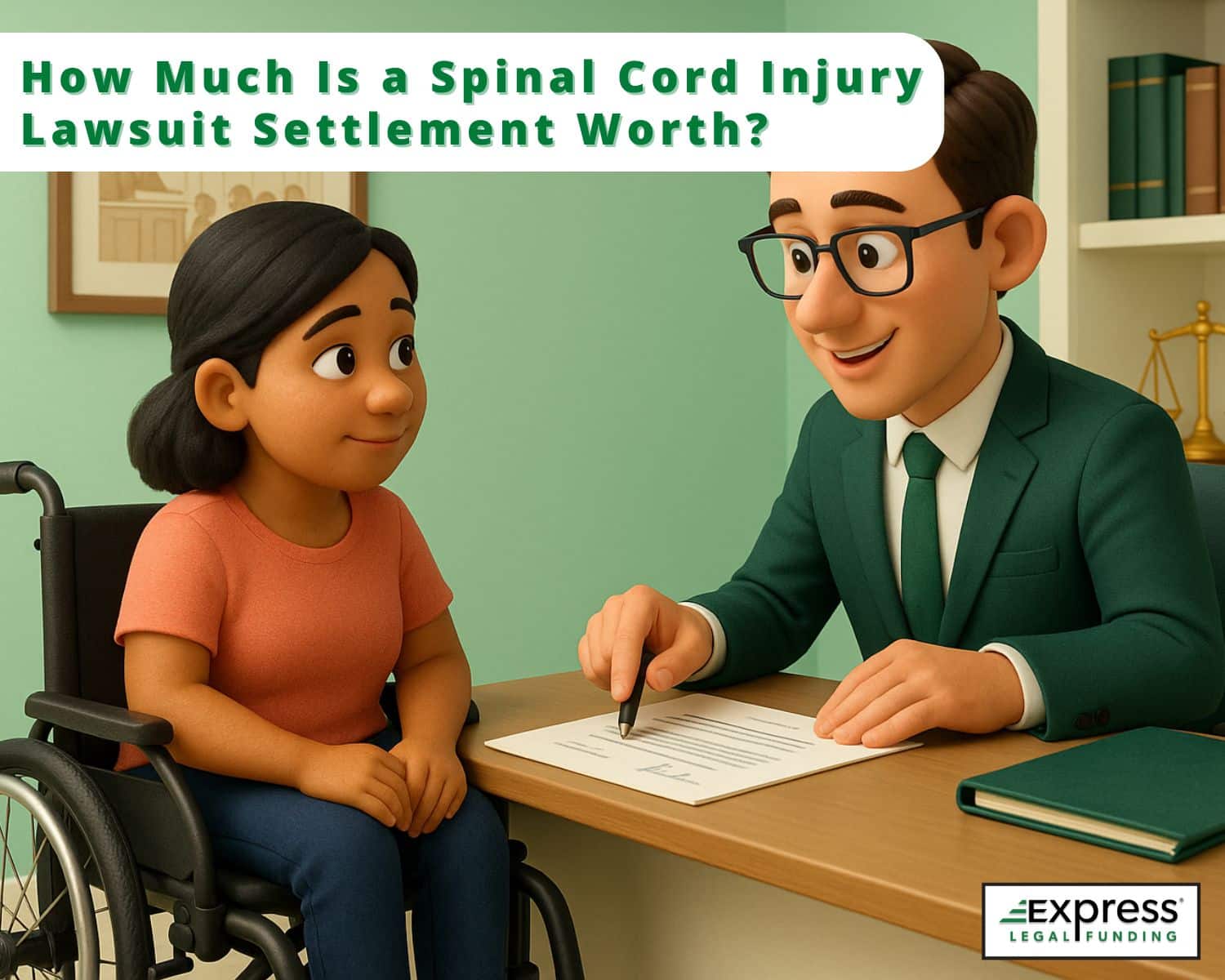
Spinal cord injuries are among the most devastating medical conditions, often resulting in profound physical, emotional, and financial challenges for victims and their families.
Given the high cost associated with these injuries, securing an appropriate settlement amount becomes crucial. Unlike other personal injury cases, spinal cord injury settlements are not determined by a fixed payout; instead, they are meticulously calculated based on a myriad of unique variables.
Understanding the emotional and psychological toll on both the victims and their families is essential in this process, as these factors significantly influence the valuation of each case.
The role of legal strategy is paramount, requiring comprehensive documentation and precise economic forecasting to ensure that the settlement adequately covers medical expenses, rehabilitation costs, and loss of income.
By carefully considering these elements, legal professionals can advocate for compensation that not only addresses immediate financial needs but also provides for the future, offering a semblance of security and stability in the face of life-altering circumstances.
In this guide, we explain all about how spinal cord injury lawsuit settlements are evaluated and the factors impacting their worth.
How Much Is a Spinal Cord Injury Lawsuit Worth? Key Settlement Factors Explained
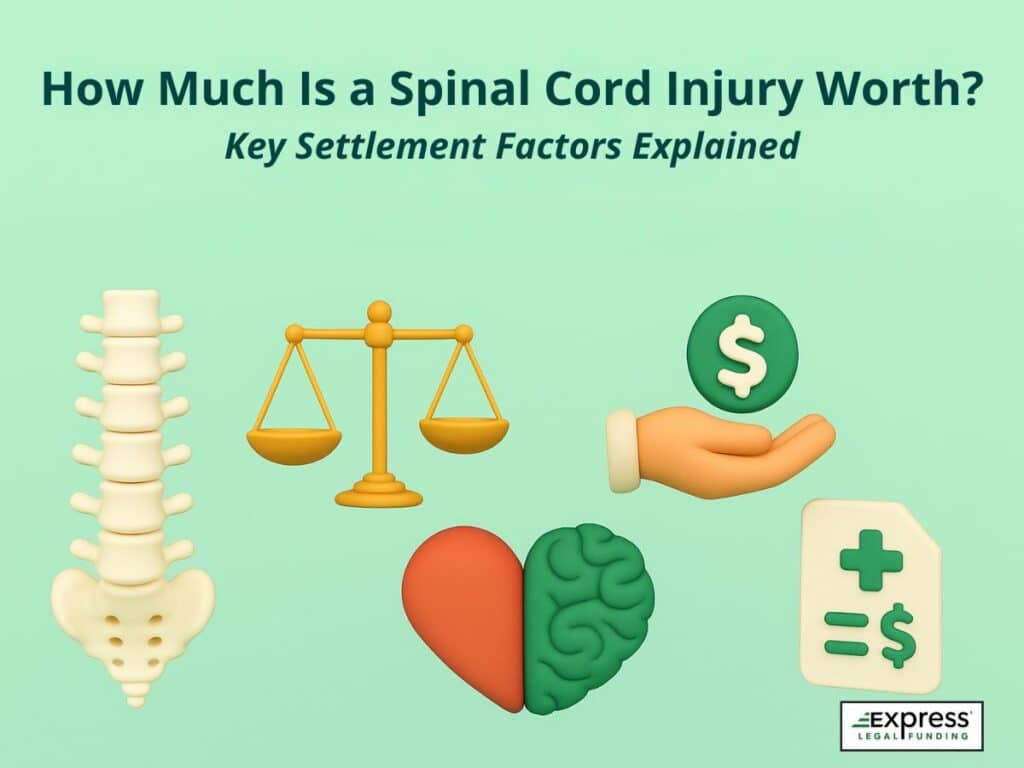
Spinal cord injury lawsuit settlements typically range from $100,000 to over $1,500,000, depending on injury severity, liability, and long-term care needs. Catastrophic cases with complete paralysis may exceed $5 million. The final payout depends on several key factors, including:
- Severity and level of the injury (e.g., cervical vs. lumbar)
- Degree of permanent disability or recovery
- Clear liability vs. shared fault
- Future medical care and rehabilitation needs
- Lost income and diminished earning capacity
- Pain, suffering, and emotional distress
- Jurisdiction and jury tendencies
Each of these elements plays a crucial role in calculating a fair settlement that reflects the long-term impact on the victim’s life.
The Role of Spinal Cord Injury Severity in Settlement Valuation
Determining the value of a spinal cord injury settlement requires a nuanced understanding of the injury’s severity and its implications on the victim’s life.
This section delves into the various factors that contribute to the valuation process, providing insights into how different types of injuries and advancements in medical treatment can affect compensation.
Complete vs. Incomplete Spinal Cord Injuries
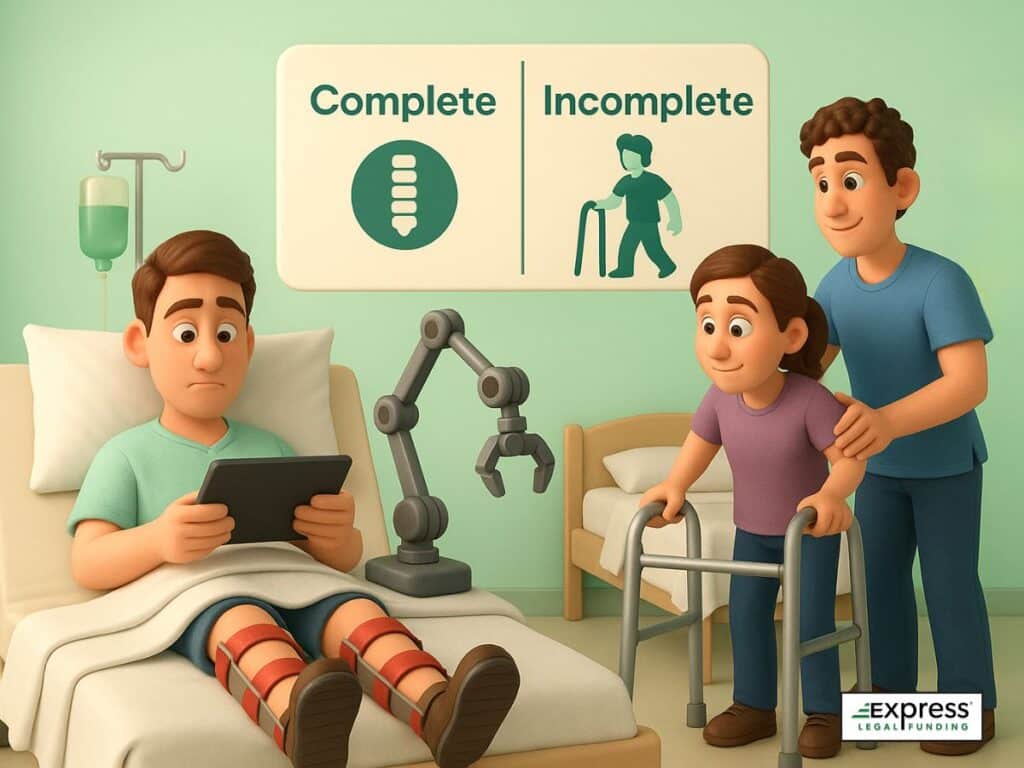
Spinal cord injuries are categorized as complete or incomplete, a distinction that significantly impacts the valuation of a case.
- Complete injuries result in a total loss of function below the injury level, meaning the affected individual may experience paralysis and loss of sensation.
- In contrast, incomplete injuries allow for some degree of movement or sensation, offering a potential for partial recovery.
Impact
- Complete injuries, with total loss of function, typically result in higher compensation due to the extensive care and support required.
- Incomplete injuries, while potentially allowing for some recovery, still necessitate significant medical intervention and rehabilitation, influencing the settlement amount based on the degree of recovery achievable.
This classification is crucial in assessing the extent of impairment and the potential for rehabilitation.
Spinal Cord Levels Affected: Cervical, Thoracic, Lumbar
The specific level of the spinal cord affected—cervical, thoracic, or lumbar—plays a vital role in determining the injury’s impact on body function.
- Cervical injuries, located in the neck region, often lead to quadriplegia, affecting both arms and legs, and can severely limit mobility and independence.
- Thoracic injuries, occurring in the upper back, may result in paraplegia, affecting the lower body.
- Lumbar injuries, found in the lower back, can impact leg function and may require assistive devices for mobility.
Impact
- Cervical injuries command higher settlements due to the profound impact on mobility and independence.
- Thoracic and lumbar injuries, while serious, may result in lower settlements compared to cervical injuries, reflecting the varying degrees of disability and required support.
Understanding these differences is essential for evaluating the injury’s impact on the victim’s daily life and long-term needs.
Permanent Disability vs. Partial Recovery
Permanent disability versus partial recovery is a critical consideration in spinal cord injury cases.
- Permanent disability may necessitate lifelong care and support, significantly increasing the settlement value.
- Factors such as spinal shock, paralysis, and neurogenic complications (e.g., neurogenic bladder or bowel dysfunction) can exacerbate the situation, requiring a comprehensive evaluation of the injury’s long-term implications.
Impact
- Permanent disability often leads to higher settlements due to the lifelong care and support required.
- Partial recovery, while offering hope for improved function, still impacts settlement value as it involves ongoing rehabilitation and potential future medical needs.
- The degree of recovery achievable can influence the compensation amount, reflecting the balance between immediate care costs and long-term support.
Legal professionals must consider these elements to ensure that compensation adequately covers future medical expenses and support services.
The Role of Medical Advancements in Treatment and Recovery for Spinal Cord Injuries
Advancements in medical treatment and rehabilitation offer hope for improved outcomes, yet they also introduce variability in prognosis. Innovations such as stem cell therapy, advanced surgical techniques, and specialized rehabilitation programs can enhance recovery prospects, potentially reducing the extent of disability.
However, these advancements must be carefully considered in the valuation process, as they can affect the estimated costs of future care and the overall settlement amount.
By thoroughly understanding the nuances of injury severity, legal and medical professionals can ensure that compensation reflects the true impact on the victim’s life, addressing both immediate needs and future challenges.
Understanding Types of Damages and Settlement Value for Spinal Cord Injuries
In spinal cord injury cases, understanding the full scope of damages is essential for determining a fair settlement value. Damages are typically categorized into economic and non-economic, each playing a crucial role in the overall compensation package.
This section explores these categories in detail, highlighting the factors that drive settlement value and the methodologies used to assess them.
Economic Damages That Drive Settlement Value

Economic damages are quantifiable financial losses incurred as a result of the injury. They form the backbone of the settlement value, encompassing various aspects of the victim’s financial burden.
Comprehensive Breakdown of Medical Expenses
Medical expenses are often the most significant component of economic damages. They include costs for hospitalization, surgeries, assistive devices, rehabilitation, and medications. These expenses are meticulously documented to ensure that the settlement covers both current and anticipated future medical needs.
Lost Wages
Lost wages account for the immediate income lost due to the injury and the long-term impact on the victim’s earning potential. This includes not only the salary lost during recovery but also any future income that may be affected by the victim’s reduced ability to work.
Home/Vehicle Modifications
In many cases, spinal cord injury victims require modifications to their homes and vehicles to accommodate their new needs. This can include ramps, lifts, mobility vans, and expenses for 24/7 caregiving. These costs are factored into the settlement to ensure the victim can maintain a level of independence and quality of life.
Future Medical Needs
Future medical needs are a critical consideration in settlement valuation. Life care plans, in-home nursing, and ongoing therapy are projected to estimate the long-term financial impact of the injury. The impact of inflation and healthcare cost trends is also considered to ensure that the settlement remains adequate over time.
Non-Economic Damages: Pain and Suffering
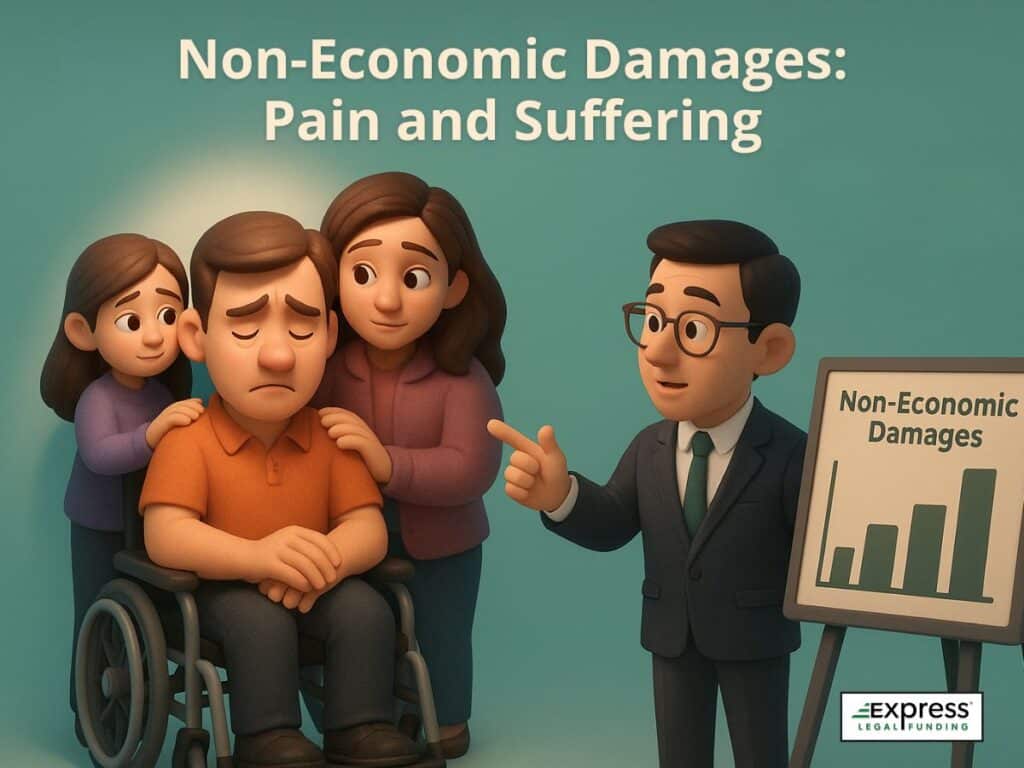
Non-economic damages address the intangible losses suffered by the victim, such as pain and suffering, mental anguish, and loss of quality of life. These damages are more challenging to quantify but are equally important in achieving a comprehensive settlement.
Legal Valuation of Mental Anguish and Emotional Toll
Attorneys use various methods to quantify non-tangible harms, such as mental anguish and emotional distress. This can involve expert testimony, psychological evaluations, and detailed narratives of the victim’s experiences.
Assessment by Juries or Insurers
Juries and insurers assess non-economic damages during negotiations or trials, considering the severity of the injury and its impact on the victim’s life. They may use multipliers or per diem calculations to arrive at a fair compensation amount.
Case Studies Illustrating Successful Non-Economic Damage Claims
Case studies provide valuable insights into how non-economic damages are successfully claimed. These examples illustrate the strategies used to convey the depth of the victim’s suffering and the resulting impact on their settlement.
By thoroughly evaluating both economic and non-economic damages, legal professionals can advocate for a settlement that truly reflects the victim’s needs and losses, providing a foundation for recovery and future stability.
Key Legal Factors That Influence Spinal Cord Injury Settlement Amounts
Each of the following components plays a crucial role in shaping the trajectory of a lawsuit and the eventual compensation awarded.
Clear Liability vs. Shared Fault: How It Affects Spinal Cord Injury Claims
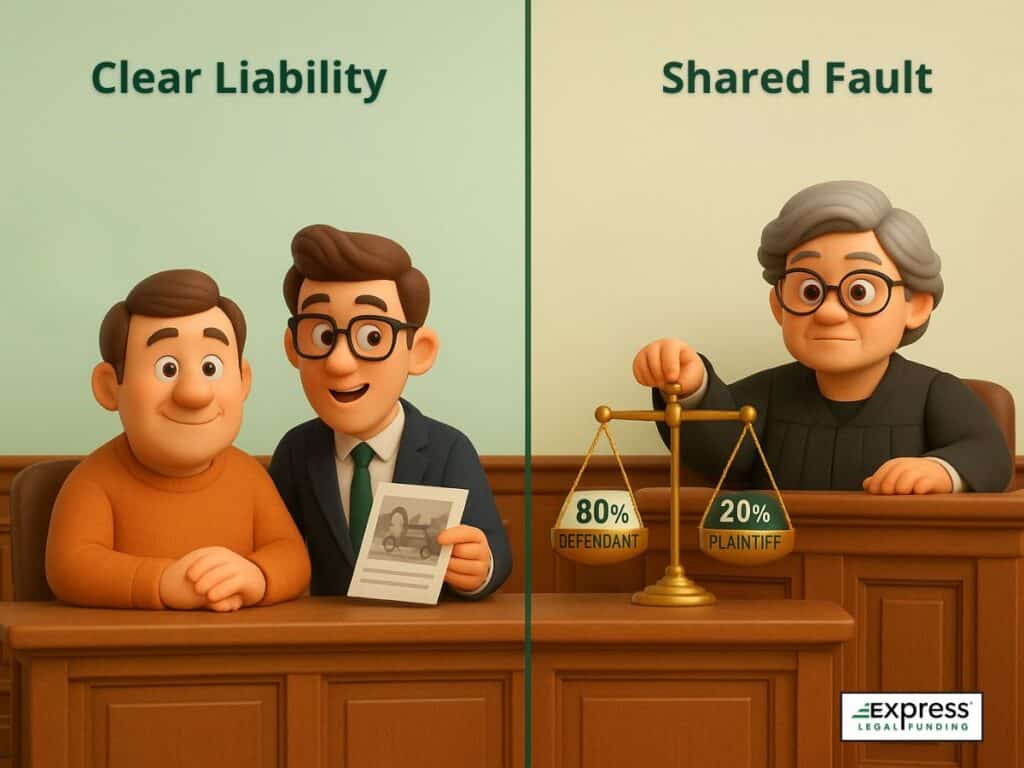
Comparative and Contributory Negligence Implications
When one party is clearly at fault for an accident, they are typically responsible for paying the full amount of the damages. This can lead to higher settlement offers. For example, if a pedestrian is legally crossing the street and is hit by a car, the driver may be fully liable, resulting in a straightforward claim.
However, if both parties share some blame, two legal doctrines may apply: comparative negligence and contributory negligence.
- Comparative negligence divides the fault between the parties involved and reduces the plaintiff’s compensation based on their share of the blame. So, if the pedestrian was jaywalking when hit, their settlement may be reduced proportionally—for example, by 20% if they are found 20% at fault.
- Contributory negligence, used in only a few states, is much stricter. Under this rule, if the injured person is found to be even 1% at fault, they may be barred from receiving any compensation at all.
In short, when shared fault is involved, the ability to recover damages can be reduced or even denied depending on the state’s negligence laws.
Defendant Type
Individual vs. Corporate vs. Government Defendants
The type of defendant involved in a case can greatly influence settlement dynamics- they can be an individual, a corporation, or a government entity.
- Individual defendants may have limited financial resources, affecting the potential settlement amount.
- Corporations, with deeper pockets, might settle quickly to avoid negative publicity.
- Government entities, protected by sovereign immunity, introduce additional complexities, potentially limiting liability and affecting compensation timelines.
Venue and Jury Tendencies
Some Jurisdictions Award Higher Damages
The venue of a legal case can profoundly affect settlement amounts, as different jurisdictions have varying tendencies in awarding damages. Some jurisdictions are known for plaintiff-friendly juries, resulting in higher awards, while others favor defendants, leading to lower settlements.
Attorneys consider these tendencies when advising clients, as the choice of venue can impact legal strategies and potential outcomes.
Strength of Legal Representation
Proven Outcomes by Experienced Spinal Cord Injury Attorneys
The caliber of legal representation is crucial in spinal cord injury cases. Experienced attorneys bring specialized knowledge and proven outcomes, navigating medical and legal complexities to secure favorable settlements.
Their expertise in building compelling cases and leveraging relationships with medical experts can be a decisive element in achieving equitable resolutions.
Thorough Documentation Increases Settlement Value
In the pursuit of maximizing the value of a spinal cord injury lawsuit, comprehensive documentation serves as a cornerstone for building a compelling case.
Importance of Meticulous Documentation
Meticulous documentation serves as the linchpin for substantiating claims and maximizing settlement value. Every detail captured in the documentation process contributes to a comprehensive portrayal of the injury’s impact, making it essential for plaintiffs to maintain thorough and organized records.
Critical Documents That Strengthen a Spinal Cord Injury Lawsuit
Here’s a comprehensive list of documents that are essential for building a strong case in spinal cord injury lawsuits. Each piece of evidence contributes to a detailed narrative of the injury’s impact.
Medical Documentation
- Emergency room reports: Initial evaluation and triage notes.
- Hospital admission and discharge summaries: Overview of diagnosis, treatment plans, and clinical progression.
- Radiology and imaging reports: X-rays, CT scans, MRIs showing spinal damage.
- Operative reports: Details from spinal surgeries or related procedures.
- Physician’s notes: Ongoing assessments from neurologists, orthopedists, and primary care doctors.
- Therapy records:
- Physical therapy
- Occupational therapy
- Speech therapy (if applicable)
- Rehabilitation program logs
Pain and Symptom Tracking
- Pain journals: Daily or weekly records maintained by the plaintiff.
- Prescription records: Medication lists and pharmacy logs.
- Assistive device prescriptions: Wheelchairs, braces, or mobility aids.
Employment and Income Records
- W-2s and tax returns: Establish lost wages and earning capacity.
- Pay stubs and employment verification letters
- Job duty documentation: To compare pre- and post-injury capabilities.
- Disability benefit applications: SSDI benefits, workers’ comp, or private insurance.
Witness and Testimony Documentation
- Eyewitness statements
- Expert witness reports: Medical, vocational, or economic experts.
- Depositions: Including those of doctors, accident witnesses, and the plaintiff.
Accident Evidence
- Police or incident reports
- Photos and videos: Scene, injuries, vehicle/property damage.
- Surveillance footage: From the location of the accident (if available).
- Insurance claims and correspondence
Legal and Insurance Records
- Attorney-client agreement
- Correspondence with insurers: Demand letters, claim denials, adjuster notes.
- Claim forms and documentation submitted to the insurance company
- Medical lien and subrogation notices
Quality of Life and Damages
- Daily care logs: Support provided by caregivers or family.
- Mental health evaluations: PTSD, depression, or anxiety diagnoses.
- Life care plan: Projected future medical and support needs.
- Home modification estimates: For accessibility improvements.
- Travel expense logs: For appointments or treatments.
Key Evidence for Spinal Cord Injury Lawsuits and Why It Matters
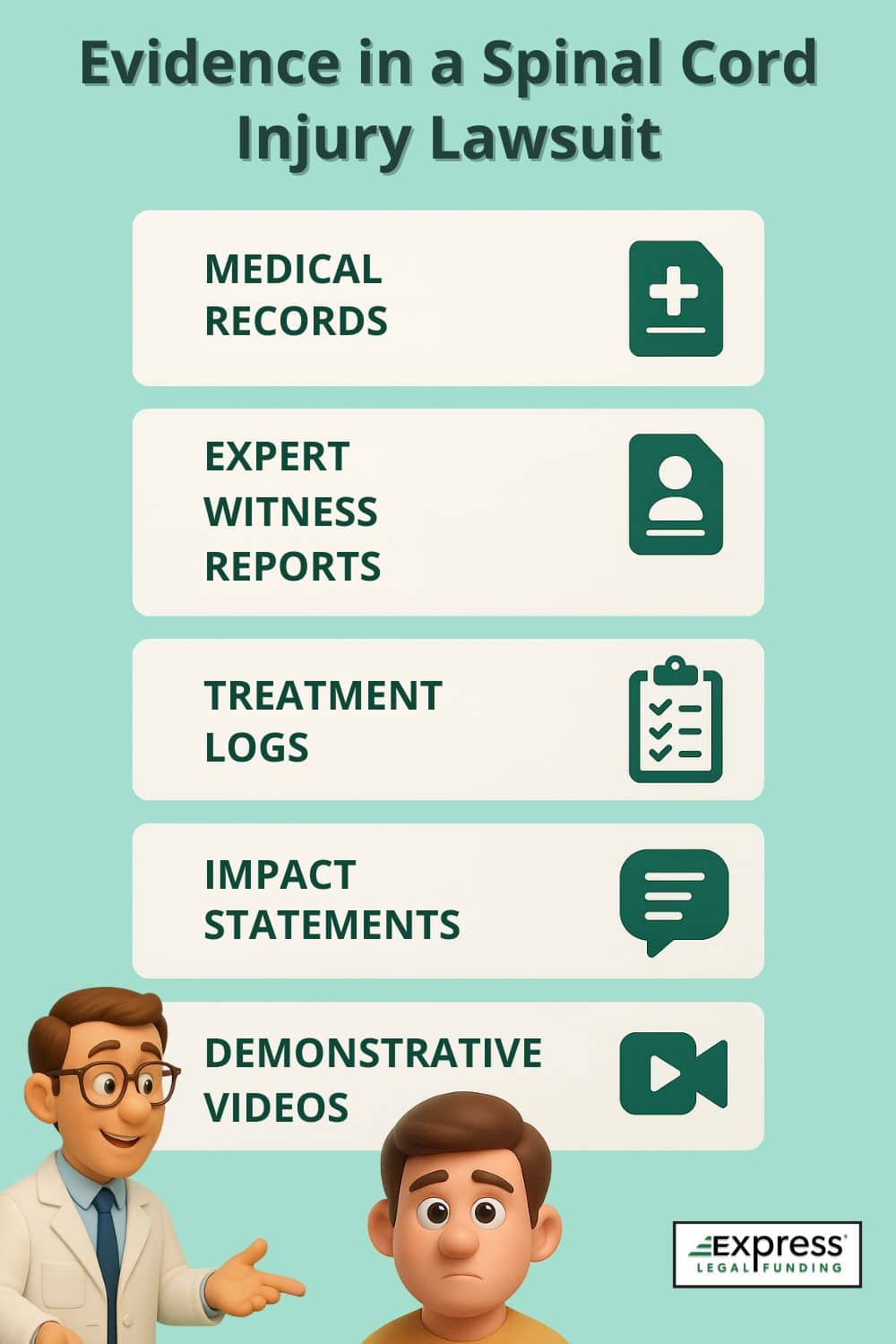
Role of Complete Medical Records, Diagnostics, and Treatment Logs
Complete medical records, diagnostics, and treatment logs play a pivotal role in spinal cord injury cases, serving as the cornerstone of the documentation that can significantly increase settlement value.
These records, including diagnostic tests such as MRIs and CT scans, surgical reports, and detailed notes, provide an exhaustive account of the injury’s progression, starting from the initial diagnosis and extending through the entire treatment process.
Learn more about the value of medical records for injuries in our guide: How Medical Records Impact Car Accident Settlements
Expert Witness Reports (Physicians, Economists, Vocational Experts)
Expert witness reports are invaluable in spinal cord injury cases, providing authoritative insights that can significantly bolster the plaintiff’s claims and enhance settlement value. Physicians, economists, and vocational experts each contribute unique perspectives that collectively paint a comprehensive picture of the injury’s impact.
Videos and Demonstratives in Litigation
Videos and demonstratives are powerful tools in spinal cord injury litigation, offering a visceral glimpse into the daily realities faced by the plaintiff. These visual aids transcend traditional documentation by vividly illustrating the physical, emotional, and logistical challenges that accompany such injuries.
Impact Statements from Family and Caregivers
Impact statements from family and caregivers are a crucial component in spinal cord injury cases, offering a deeply personal perspective on the plaintiff’s journey and the ripple effects of the injury on their immediate circle.
These statements provide a narrative that goes beyond medical and financial documentation, capturing the emotional and relational dynamics altered by the injury.
Innovative Documentation Techniques and Technologies
Innovative documentation techniques and technologies, such as 3D MRI and augmented reality, are revolutionizing the way spinal cord injury cases are presented, offering new avenues to enhance settlement value.
These advancements allow for a more dynamic and immersive portrayal of the plaintiff’s experience, bridging the gap between complex medical data and the tangible realities of living with a spinal cord injury.
Exploring National Settlement Ranges for Spinal Cord Injuries
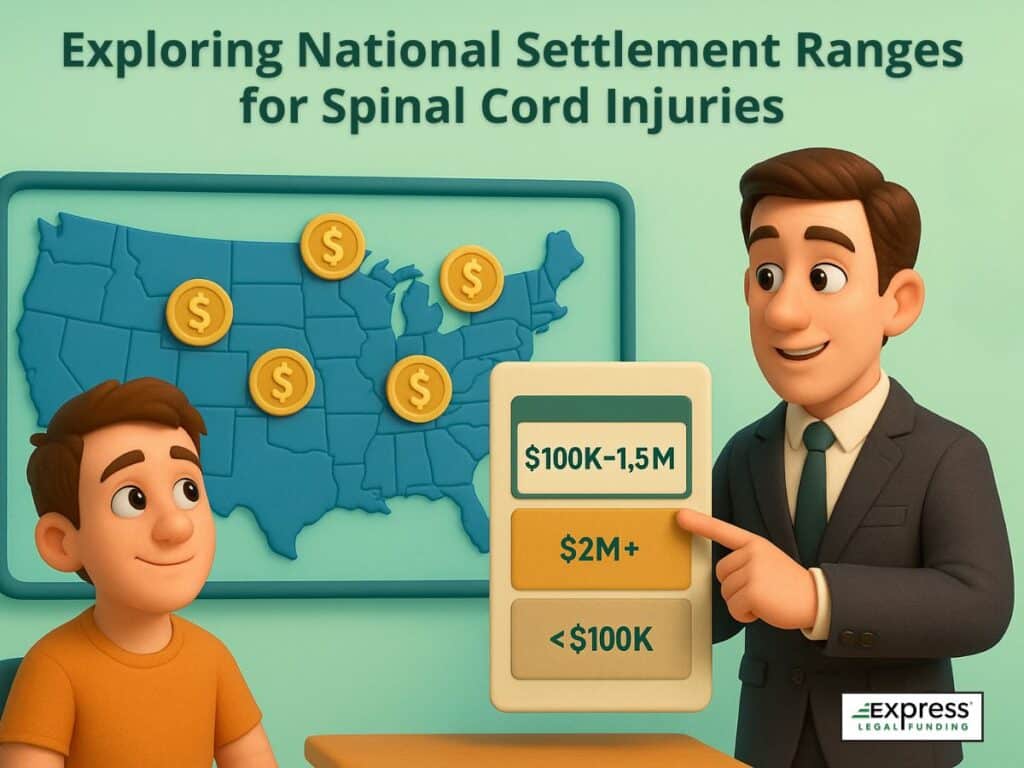
Spinal cord injury lawsuits are among the most high-stakes personal injury claims in the legal system. Compensation amounts vary widely, reflecting not only the severity of the injury but also the legal and medical standards applied in each case.
While no two settlements are identical, national and state-level data reveal discernible patterns.
Typical Settlement Range for Spinal Cord Injuries
Across the United States, spinal cord injury settlements generally fall within the range of $100,000 to $1,500,000. This broad range accounts for cases involving moderate trauma with partial recovery on the lower end, and severe, life-altering injuries, such as paraplegia or quadriplegia, on the higher end.
Cases that proceed to trial and result in jury verdicts may yield even larger awards, especially when ongoing care, loss of earning capacity, and long-term disability are well substantiated.
Outliers: Catastrophic Paralysis vs. Soft-Tissue Claims
At the top end of the spectrum are cases involving complete spinal cord transection, where individuals lose function below the site of injury. These can produce verdicts or settlements exceeding $5 million, particularly if the plaintiff is young, employed at the time of injury, and requires round-the-clock care.
In contrast, soft-tissue or incomplete spinal injuries, such as disc herniation without nerve damage, often resolve for far less, typically under $100,000. These cases may involve disputes about causation or the extent of impairment, especially if pre-existing conditions are present.
Relevant read: Can You Get Nerve Damage From a Car Accident?
National Data Snapshot
While comprehensive databases for all spinal cord settlements are limited, several studies and legal analytics platforms provide insight:
- A JVR (Jury Verdict Research) report placed the median award for spinal cord injury cases at approximately $500,000, with mean verdicts exceeding $2.4 million, skewed by high-value catastrophic cases.
- According to NCSC (National Center for State Courts) research, spinal cord claims resolved by jury trial tend to receive some of the highest compensatory awards among all personal injury categories.
State-by-State Variations in Spinal Cord Injury Lawsuit Payouts
Settlement outcomes also fluctuate based on jurisdiction. Some contributing factors include:
- Comparative negligence laws: States like California and New York, which follow pure comparative fault rules, may still allow partial recovery even if the plaintiff shares significant blame. In contrast, North Carolina and Maryland, which apply contributory negligence, can bar recovery entirely if the plaintiff is even 1% at fault.
- Damage caps: States like California and Texas impose statutory limits on non-economic damages in medical malpractice cases, which can significantly limit total compensation for spinal cord injury victims. Virginia goes further by enforcing a combined cap on both economic and non-economic damages.
- Jury reputation: Courts in Illinois, Florida, and New Jersey are known for plaintiff-friendly jury awards, while others, such as Indiana and Missouri, tend to favor more conservative outcomes.
- Healthcare cost benchmarks: States with higher medical costs (e.g., California, New York, Massachusetts) often see higher settlements due to greater recoverable medical damages.
The statute of limitations for spinal injury lawsuits varies by state. Learn more in our guide: Statute of Limitations for Spinal Injury Lawsuits
Get Pre-Settlement Funding on Your Spinal Injury Lawsuit with Express Legal Funding
Suffering a spinal injury can be physically, emotionally, and financially overwhelming, especially when your case is still pending in court. At Express Legal Funding, we understand how costly these injuries can be. From hospital bills and physical therapy to lost income and mobility aids, the expenses add up quickly.
That’s where we can help.

Express Legal Funding offers pre-settlement funding—a risk-free cash advance provided to plaintiffs involved in personal injury lawsuits, including those suffering from serious spinal injuries. This type of legal funding is not a loan, which means you only repay the advance if you win or settle your case. If you lose, you owe us nothing.
We provide fast and affordable financial support to help you:
- Pay for essential living expenses while you recover
- Cover medical costs, such as surgery, rehabilitation, or mobility equipment
- Avoid pressure to accept a lowball settlement offer
Whether your injury involves the cervical, thoracic, lumbar, or sacral spine, we offer funding tailored to the severity and strength of your case. Our team works directly with your attorney to review your claim quickly and get you cash, often in less than 24 hours of approval.
Apply for Fast Pre-Settlement Funding Today
Don’t let financial stress worsen an already difficult situation. Contact Express Legal Funding today to find out how much you can receive as a pre-settlement advance while waiting for your spinal injury case to settle.
➡️ Apply Now for Pre-Settlement Funding or call us at (888) 232-9223 to get started.
Frequently Asked Questions about the Value of Spinal Cord Injury Lawsuit Settlements
What is the average spinal cord injury settlement for car accidents?
Settlements for spinal cord injuries caused by auto accidents typically range from $300,000 to $1,250,000, depending on the severity of the trauma, liability clarity, and ongoing medical needs.
Catastrophic injuries involving paralysis may result in settlements exceeding $2 million, especially if lifelong care is required. In moderate cases involving partial mobility loss or spinal fusion, payouts often fall between $150,000 and $500,000.
Do soft-tissue or non-surgical spinal injuries qualify for high payouts?
Generally, soft-tissue injuries that do not require surgery receive lower compensation. These claims typically settle for $20,000 to $75,000, especially if imaging studies (MRI, CT scans) show no significant nerve damage or vertebral instability. Higher payouts are possible if the injury results in long-term impairment or substantial wage loss, but such cases require strong medical evidence and clear proof of causation.
Can I receive compensation for future spine surgeries or rehab?
Yes. Settlements can include projected costs for future medical care, including surgery, physical therapy, assistive devices, and in-home care. Life care plans are often developed by medical economists to estimate future expenses. In serious cases, future medical damages may account for 40% or more of the total settlement, with awards exceeding $500,000 specifically allocated for long-term treatment and rehabilitation.
Will my final settlement be reduced if I take pre-settlement funding?
No, the total settlement amount stays the same, but the amount you take home (net recovery) will be lower because the legal funding company is repaid from your portion. Pre-settlement funding is not considered income and isn’t deducted by the defendant or insurer. Instead, it’s repaid after your case settles.
For example, if your case settles for $300,000 and you borrowed $20,000 in funding (plus fees), that repayment comes out of your share of the settlement. So while the settlement amount doesn’t change, your final take-home compensation will be reduced accordingly. That’s why it’s wise to borrow only what you truly need.
What if my spinal injury worsens after the initial claim is filed?
If the deterioration occurs before the case is settled or adjudicated, updated medical evaluations and new evidence can be submitted to reflect the worsened condition, which may increase the claim’s value.
However, once a settlement is finalized and accepted, the case typically cannot be reopened. For this reason, plaintiffs are advised to wait until their condition stabilizes or reaches maximum medical improvement (MMI) before resolving the claim.

